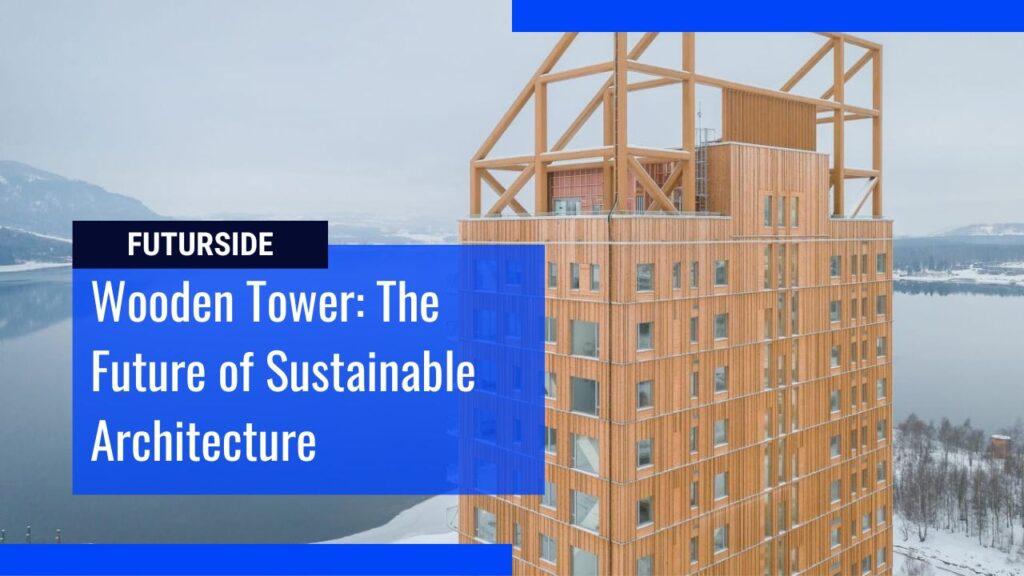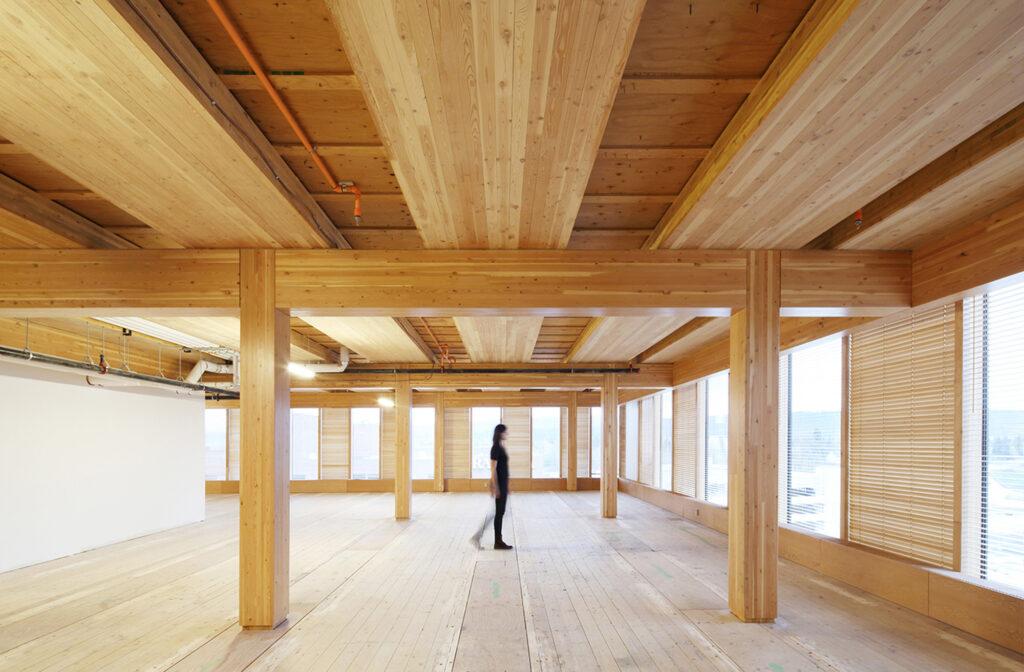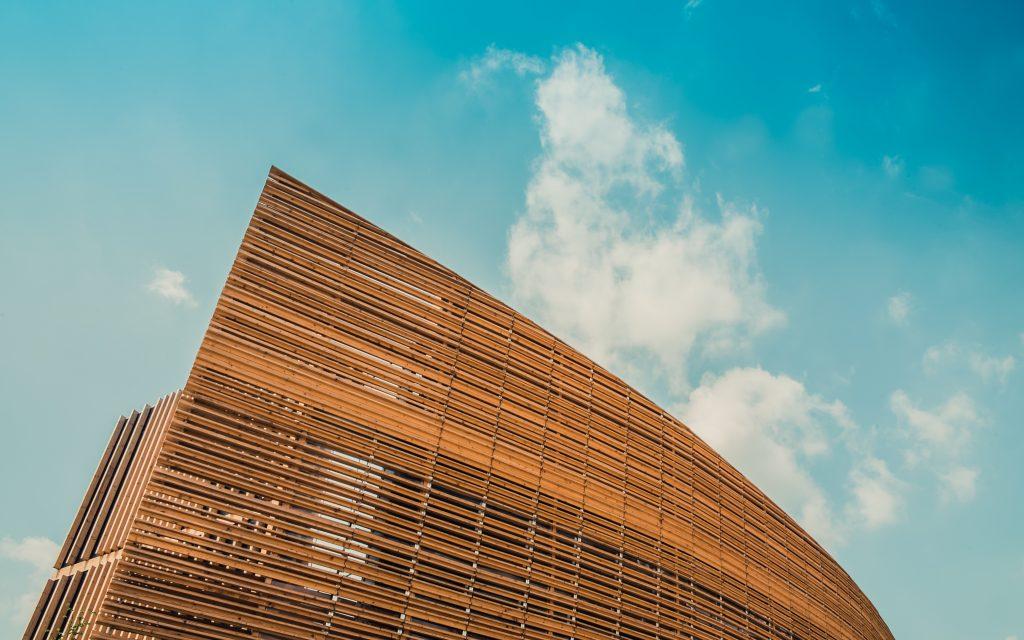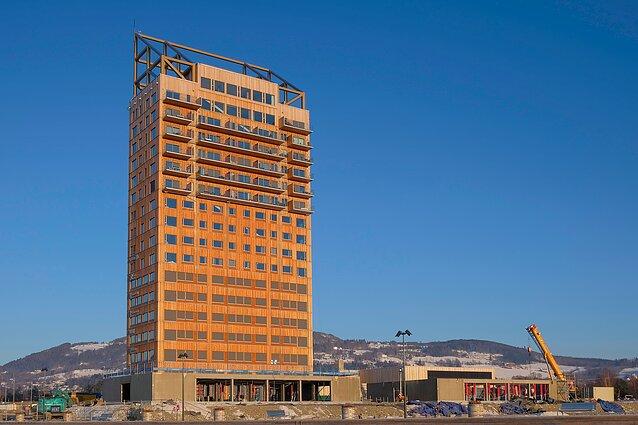Skyscrapers have always been the symbol of modern ambition. The race to build the tallest and biggest building has been fueled by steel and concrete. And the race to build more edifices has been fuelled by a growing population living in urban areas. Today more than half of the world’s population lives in cities and that number keeps growing.
More people mean more and bigger buildings. It is expected that by 2050 the world’s population will soar to almost 10 billion people and two-thirds of them will be living in cities. So over the next 30 years, new homes will need to be built. But the challenge is that cities are built with two main materials which are steel and concrete.
These materials consume very high energy and produce greenhouse gas emissions in their process. Steel represents about 3% of greenhouse gas emissions and concrete is over 5%. This means that 8% of our contribution to greenhouse gases today comes from those two materials alone.
So we need to find ways to build skyscrapers more sustainably for our growing populations. Architects can no longer ignore their responsibilities toward choosing more eco-friendly and sustainable materials. And the answer might lie in a natural material we’ve been using for millennia. There’s a lot of unrealized potential for using timber at a very large scale.
Throughout human history, buildings and houses have been made from wood. But at that time it has a major drawback, fire can easily destroy a large portion of a city. Then by the start of the 20th century, the era of steelmaking had arrived. Steel was strong, could be molded into any shape and used to reinforce concrete. And it allowed architects to build higher than ever before.
However, concrete and steel are costly to produce and heavy to transport. Wood on the other hand can be grown sustainably and it’s lighter. It can be grown from sustainably-managed forests and engineered in factories. The old problems of strength, fire and deforestation are also being answered. So what are the potentials of wooden buildings?

Contents
What is a wooden building?
The concept is simple but interesting. A wooden skyscraper is a massive structure made of mass timber. The structure is typically at least 100 meters high. While wood has been viewed as an unreliable material for high-rise buildings, scientists are now testing the durability of specially designed wooden buildings.
Mass timber is used to build larger projects with wooden supports. This includes heavy timber, dimensional lumber and innovative products such as Cross-Laminated Timber and Glue Laminated Timber. These innovative products have the potential to outlast concrete buildings and can even be used to construct entire edifices.
Traditional boards of lumber lacked steel’s tensile strength or concrete’s compressive strength. These two properties are necessary to support tall buildings and battle powerful winds at high altitudes. But now with the invention of Cross Laminated Timber (CLT) and Glue-Laminated Timber (glulam), engineers have solved these two problems.
These new wooden materials start like all other lumber. It is a freshly cut log that is sawed into smooth uniform boards of wood. Then the boards are glued together in alternating orientations. The resulting material is a wooden structural rigidity in every direction, allowing it to mimic the compressive strength of concrete and bear loads up to 20 times heavier than traditional lumber.
Glulam, on the other hand, are glued boards in the same direction, forming massive beams with a tensile strength comparable to steel. Glulam isn’t as versatile as CLT but its incredible strength makes it superior for load-bearing beams and columns. Engineered wood can compete with traditional materials with its own unique set of advantages.

Advantages of wooden buildings compared to concrete buildings
Wood can stand at one-fifth the weight of concrete. Building with CLT requires smaller cranes, smaller foundations and fewer construction workers. On the other hand, concrete has to undergo time-intensive processes, from casting and curing in a mold. Timber can also be shaped quickly using computer-directed cutting machines.
Concrete depends on certain weather and timing conditions to be poured on-site whereas engineered wood can be prefabricated in a factory sheltered outside conditions. Wood construction allows for faster and quieter construction with more biodegradable materials and less waste.
One of the biggest problems with steel skyscrapers is that they have to be built with concrete, which takes weeks to dry. Wooden buildings, on the other hand, can be cut to exact sizes and slotted into place within a few hours. Wood also has a low thermal conductivity which makes it easier to heat and cool while requiring and wasting less energy in the process.
Concrete construction produces a lot of waste whereas wooden skyscrapers less. Also, the waste generated and material left from timber construction can be used for other building projects. On top of that, wooden edifices can be easily renovated or extended without creating much of a hassle. It can also be recycled or dismantled.
CLT and glulam buildings are also more resilient to some natural disasters such as earthquakes since concrete can crack under the same condition or permanently weaken its entire structure. Cracked wood panels on the other hand can be easily replaced. This advantage can also be applied to fire safety.
In case of a fire incident in a CLT building, the wooden outer layer will be charred, insulating the inner layers for up to three hours giving enough time to evacuate the buildings. And charred panels can be easily swapped out, unlike melted steel beams. But perhaps the biggest benefit of CLT and glulam to traditional buildings is that they emit fewer carbon emissions.
And the production of steel, concrete, iron and glass are major contributors to climate change throughout the entire supply chain from extraction to production. Timber on the other hand is a renewable resource meaning it is carbon-neutral and trees can be sustainably grown and those cut down can be replanted.
Why wooden building is important?
A wooden skyscraper is a great option for residential accommodation. It insulates the edifice well both thermally and acoustically, making them better than masonry and classic modern buildings. Unlike other building materials, wood is relatively lightweight, making it an ideal choice for urban properties.
Moreover, mass timber buildings often leave the wood exposed, requiring minimal wrapping to comply with local codes. In addition to these advantages, wood is a connection to nature that is soothing and comforting. What’s more beautiful is that people can touch and feel the texture of the wood.
Wood texture is like a fingerprint and each piece has a unique one. Wood gives mother nature’s fingerprint in our buildings. And as trees grow they absorb carbon dioxide from the air. One study showed that using wood to construct a 125-meter skyscraper could reduce the building’s carbon footprint by up to 75%.
Wooden buildings are also faster to build. Because many elements of the edifice are prefabricated, they require less time to construct. Additionally, wood buildings are more sustainable than other types of construction. As it is made of renewable resources.
The biggest benefit is the sustainability of wood. Since wood is a natural material, it is renewable and can be sustainably grown in abundance. In addition to being sustainable, wood captures carbon during its life as a living tree. During photosynthesis, trees absorb CO2 and that carbon remains in the tree.
A wooden skyscraper can help combat climate change. Trees absorb CO2 and release it back into the atmosphere when they decompose. But the carbon trapped in the timber of a wooden building will be trapped there as long as it is standing. A wooden edifice stores carbon and prevent it from entering the atmosphere.

Researchers at the Yale University of Washington found that wood construction can reduce carbon emissions and sequester them. The study suggests that expanding wood construction would eliminate the need for new fossil fuels and could reduce carbon emissions. By eliminating these emissions, wood could equal all of the energy used to build steel and concrete buildings.
It would take centuries to capture the carbon emissions created by construction projects combined. However, a wood building would reduce carbon footprints compared to a concrete skyscraper by around 2,800 tons. However, if we want to build a wooden skyscraper in the future, we need to look beyond the environmental benefits.
While mass timber can help to reduce carbon emissions, there are concerns over the risk of fire. CLT and glulam can resist fire to some extent. Tall wooden buildings can meet the minimum fire protection rating of two hours with sprinklers. This helps to mitigate danger in the early stages, allowing occupants to escape and the fire to be brought under control.
Small wooden planks are flammable but large sections can withstand fire temperatures of over 982 degrees Fahrenheit. And a charred surface protects the underlying structure from heat and oxygen. There are many reasons why we should consider mass timber as a construction material.
The reason for the growing interest in a wooden skyscraper is that it is environmentally friendly. Consequently, it is a great choice for cities where there is high population density and subject to island heat effects. Mass timber buildings aren’t just for high-profile projects. They are making their way into ordinary buildings.
The construction of concrete skyscrapers requires an immense amount of energy while wooden buildings are extremely light. Wood buildings are also easier to assemble. The price of laminated wood materials is still higher than that of steel. However, the cost is decreasing as there is a growing interest in wood buildings.
Another advantage of a wooden skyscraper is that it is also more flexible and resilient to earthquakes than concrete. Wood also does not require concrete floors, which take weeks to dry. It can be cut to exact specifications and slotted into place within hours, compared to weeks for a steel skyscraper. A timber building still requires a substantial investment in research and development.
Advantages of a wooden building
Wooden buildings offer many advantages. The materials are extremely durable and offer a range of inherent advantages. Wood is an excellent option for many reasons, including environmental and aesthetic appeal. In addition to this, wood can maintain its properties for generations with proper moisture management.
While a wood-intensive building is not a carbon-neutral option, there are several positive environmental impacts of wooden buildings. Wood can be a sustainable option due to its biogenic carbon storage effect. It also contributes to climate protection targets due to its ability to reduce emissions.
However as wooden buildings and their products have lower greenhouse gas emissions than non-wood-based buildings, they can still contribute to global warming. These environmental benefits are largely due to their sustainability benefits. A study in the UK found that the impact of wooden buildings on climate change is minimal.
In addition to reducing the environmental impact, wood is also renewable. Because the trees used for wood construction are renewable, their production and use consume less energy. Trees also naturally absorb CO2 from the atmosphere, so they have zero energy costs. Wooden buildings also have a long-term carbon storage potential, which can make them a valuable addition to energy-efficient buildings in the future.
Additionally, it has a lower carbon footprint than buildings made of other materials. A typical wood-frame home in North America can store up to 30 tonnes of carbon, which is equivalent to the emissions produced by a family car for five years. In addition, federally funded research is continually proving the many benefits of using wood for building construction.

Wood is the only carbon-neutral construction material. In fact, just 20 cubic meters of wood can save up to 16 tonnes of carbon, the equivalent of what we produce in 90 thousand miles of driving. Wooden buildings are also more cost-effective than their steel or concrete counterparts.
These edifices are cheaper to build and operate. Compared to other building materials, wood is far more cost-effective. Unlike metal or other building materials, wood does not require heavy foundations, which means less land preparation. Because wood breathes, wooden buildings can be constructed without expensive ventilation systems.
They also offer superior thermal insulation properties, which reduce heating costs. For these reasons, wood buildings are a good choice for urban areas. Additionally, wood is a renewable resource. In Sweden, for every tree harvested, two new trees are planted. Another benefit is their low weight.
The weight of wood reduces foundation costs and makes construction time faster. The wood used in wooden buildings is easy to work with and often requires less skill than concrete. Wood also has a higher rate of wood rot, but this can be remedied with certain treatments. It also has lower water consumption than concrete buildings.
Wood is an extremely durable material. When properly cared for, wood can last hundreds of years. Additionally, new wood preservatives can extend the life of wooden buildings. Additionally, wood is capable of withstanding all types of weather. Heavy timber construction, for example, can develop an outer layer of char and remain structurally sound.
Examples of wooden buildings
Wooden buildings can be a viable alternative to concrete and steel. The development of this material has led to new developments in the field of architecture. Several new building styles have been introduced in recent decades. In Sweden, for example, cross-laminated timber was developed. By combining cross-laminated timber and steel, a wood-frame building can rise to 12 stories.
Tall wooden buildings are becoming more popular. Growing urbanization and environmental concerns have led to the creation of a new category of buildings. Several wooden skyscrapers are already in use. The Sara Cultural Centre is an example of how cities can respond to the growing climate crisis. Despite its modest size, the Sara Cultural Centre is the second tallest wooden skyscraper in the world.
The nine-story Stadthaus by Andrew Waugh and Anthony Thistleton in London can store 186 tons of carbon. Cross-laminated timber is a new favorite of unconventional architects, with some calling it “plywood on steroids”. The proposed 80-story wooden tower in Chicago is a good example of the use of mass timber.
However, there are many other variations of this building concept. The Vancouver dormitory building is one example. Currently, under construction near downtown Vancouver, the University of British Columbia is creating an eighteen-story wooden dormitory. This building is slated to be the tallest wooden building in the world.
The Mjøstårnet is a record-holding 18-story mixed-use building in Brumunddal, Norway, completed in March 2019. The building is officially the world’s tallest timber building rising at 85.4 m (280 ft) tall. Another example of a wooden skyscraper is the Wood Innovation and Design Centre in Prince George, Canada.
The Sara Kulturhus is a 20-story wooden structure that opened in Skelleftea, Sweden, in September 2017. The building contains six theatre stages, a library, two art galleries, a conference center, a 205-room hotel and a concert hall. It is a sustainable building that cuts atmospheric pollution by reducing CO2 emissions. Another example is the Ascent MKE, a luxury residential mass-timber tower. The tower will be taller than Mjøstårnet and will likely be the tallest in the world.
Future of wooden building
The future of wooden buildings is based on the demand for green buildings. It can be a cost-effective alternative to steel and concrete. Wood can be manufactured into different forms, including square blocks, to minimize wastage of value creation. Wood is a renewable material and can be used to create byproducts for the bioenergy sector.
Several factors have contributed to the increasing price of wood but the benefits of wooden construction are well worth the increased cost. One of the most significant benefits of mass timber is the reduction of carbon emissions. Mass timber buildings can reduce carbon emissions by more than four times higher quality than steel or concrete buildings.
However, mass timber is not a magic wand. While mass timber can significantly cut a structure’s carbon footprint, other factors must be considered as well, including the facade, insulation and mechanical systems. For example, if a building is made up of a mass of T3 wood, its carbon footprint is a third less than steel or concrete.
Wooden construction has a long history of use as a building material. While it fell out of fashion in the nineteenth century, new developments in timber manufacturing are changing the future of wooden buildings. A research team from the University of Cambridge and a private architecture firm have teamed up to design a wooden skyscraper that could reach 300 meters.
With mass timber construction becoming more popular and affordable, more countries are adopting wooden skyscrapers. Hundreds of mass timber buildings have already been built throughout the world and ambitious large projects are emerging frequently. The future of wooden buildings depends on mass timber as it offers many advantages over conventional wood construction.
Because mass timber is lightweight and stronger than concrete or steel, it can compete with non-wood building materials in strength. Wood is nature’s fingerprint in buildings and it has a soothing effect that makes it appealing to people. Increasingly, mass timber buildings are being built in cities across the world.
A recent study published in the journal of sustainable architecture and building suggests that wood may be the future of buildings. Cross-laminated timber is replacing concrete and steel in modern construction. However, despite its advantages over concrete and steel, CLT requires a vast amount of lumber than traditional wooden construction.
And also neither CLT nor glulam is as strong as steel or concrete. Taking that into consideration, it is unlikely that a purely wooden structure would be strong enough to support a 40-story building which is the minimum height for a formal skyscraper.
But even if wooden buildings cannot go as high as traditional buildings, it reduces the carbon footprint of those structures by more than 25%. So no matter how tall these wooden buildings rise, they can contribute to the health of our concrete jungles creating a sustainable green city in the process.

0 Comments